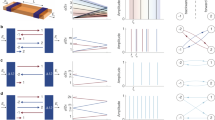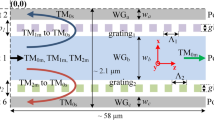Abstract
We characterize a system consisting of a two-mode waveguide coupled to a single-mode microring resonator possibly presenting a nonlinear response of Kerr type. By using the scattering parameter formalism extended to the multimode domain, we show that in the linear regime and for an ideally transparent medium, each resonance of the system can be exploited to perform complete even-to-odd (respectively, odd-to-even) modal conversion. Moreover, when the Kerr nonlinearity is effective, the microring enables a power-dependent modal switching mediated by phase bistability. Thanks to its mode-processing capabilities, this configuration is suitable to find application as a functional building-block in mode-division multiplexing (MDM) photonic integrated circuits.








Similar content being viewed by others
Notes
By means of simple analytical evaluations made on slab waveguides, one can quickly verify the validity of this assumption, as long as \(WG_1\) remains reasonably far from the system made by \(WG_2+WG_3\). In fact, given the transverse power distribution of the modes in this configuration, the overlap integral between \(WG_1\) and \(WG_3\) (which is roughly proportional to the coupling constant) appears to be vanishingly smaller than the one between \(WG_1\) and \(WG_2\).
References
Bergman, K., Carloni, L.P., Biberman, A., Chan, J., Hendry, G.: Photonic Network-on-Chip Design. Springer, New York (2014). doi:10.1007/978-1-4419-9335-9
Boucher, Y.G.: Analytical model for the coupling constant of a directional coupler in terms of slab waveguides. Opt. Eng. 53(7), 071810 (2014). doi:10.1117/1.OE.53.7.071810
Boyd, R.W.: Nonlinear Optics, 3rd edn. Academic, New York (2008)
Chen, S., Zhang, L., Fei, Y., Cao, T.: Bistability and self-pulsation phenomena in silicon microring resonators based on nonlinear optical effects. Opt. Express 20(7), 7454–7468 (2012). doi:10.1364/OE.20.007454. http://www.opticsexpress.org/abstract.cfm?URI=oe-20-7-7454
Ding, Y., Xu, J., Ros, F.D., Huang, B., Ou, H., Peucheret, C.: On-chip two-mode division multiplexing using tapered directional coupler-based mode multiplexer and demultiplexer. Opt. Express 21(8), 10376–10382 (2013). doi:10.1364/OE.21.010376. http://www.opticsexpress.org/abstract.cfm?URI=oe-21-8-10376
Dumeige, Y., Féron, P.: Dispersive tristability in microring resonators. Phys. Rev. E 72, 066609 (2005). doi:10.1103/PhysRevE.72.066609
Luo, L.W., Ophir, N., C.P.Chen, Gabrielli, L., Poitras, C., Bergman, K., Lipson, M.: WDM-compatible mode-division multiplexing on a silicon chip. Nat. Commun. 5(3069) (2014). doi:10.1038/ncomms4069
Matsko, A.B., Savchenkov, A.A., Strekalov, D., Ilchenko, V.S., Maleki, L.: Optical hyperparametric oscillations in a whispering-gallery-mode resonator: threshold and phase diffusion. Phys. Rev. A 71, 033804 (2005). doi:10.1103/PhysRevA.71.033804
Miller, D.A.B.: Device requirements for optical interconnects to silicon chips. Proc. IEEE 97(7), 1166–1185 (2009). doi:10.1109/JPROC.2009.2014298
Parini, A., Bellanca, G., Annoni, A., Morichetti, F., Melloni, A., Strain, M., Sorel, M., Gay, M., Pareige, C., Bramerie, L., Thual, M.: BER evaluation of a passive SOI WDM router. IEEE Photon. Technol. Lett. 25(23), 2285–2288 (2013). doi:10.1109/LPT.2013.2285248
Peucheret, C., Ding, Y., Xu, J., Ros, F.D., Parini, A., Ou, H.: Signal processing for On-Chip Space Division Multiplexing. In: Advanced Photonics 2015, p. SpT2E.3. Optical Society of America (2015). doi:10.1364/SPPCOM.2015.SpT2E.3. http://www.osapublishing.org/abstract.cfm?URI=SPPCom-2015-SpT2E.3
Poon, A., Luo, X., Xu, F., Chen, H.: Cascaded microresonator-based matrix switch for silicon on-chip optical interconnection. Proc. IEEE 97(7), 1216–1238 (2009). doi:10.1109/JPROC.2009.2014884
Rasoloniaina, A., Huet, V., Thual, M., Balac, S., Féron, P., Dumeige, Y.: Analysis of third-order nonlinearity effects in very high-q wgm resonator cavity ringdown spectroscopy. J. Opt. Soc. Am. B 32(3), 370–378 (2015). doi:10.1364/JOSAB.32.000370. http://josab.osa.org/abstract.cfm?URI=josab-32-3-370
Rukhlenko, I.D., Premaratne, M., Agrawal, G.P.: Analytical study of optical bistability in silicon ring resonators. Opt. Lett. 35(1), 55–57 (2010). doi:10.1364/OL.35.000055. http://ol.osa.org/abstract.cfm?URI=ol-35-1-55
Sarid, D.: Analysis of bistability in a ring-channel waveguide. Opt. Lett. 6(11), 552–553 (1981). doi:10.1364/OL.6.000552. http://ol.osa.org/abstract.cfm?URI=ol-6-11-552
Shacham, A., Bergman, K., Carloni, L.: Photonic networks-on-chip for future generations of chip multiprocessors. IEEE Trans. Comput. 57(9), 1246–1260 (2008). doi:10.1109/TC.2008.78
Sherwood-Droz, N., Wang, H., Chen, L., Lee, B.G., Biberman, A., Bergman, K., Lipson, M.: Optical \(4\times 4\) hitless silicon router for optical Networks-on-Chip (NoC). Opt. Express 16(20), 15915–15922 (2008). doi:10.1364/OE.16.015915. http://www.opticsexpress.org/abstract.cfm?URI=oe-16-20-15915
Stern, B., Zhu, X., Chen, C.P., Tzuang, L.D., Cardenas, J., Bergman, K., Lipson, M.: On-chip mode-division multiplexing switch. Optica 2(6), 530–535 (2015). doi:10.1364/OPTICA.2.000530. http://www.osapublishing.org/optica/abstract.cfm?URI=optica-2-6-530
Sun, C., Yu, Y., Chen, G., Zhang, X.: Integrated switchable mode exchange for reconfigurable mode-multiplexing optical networks. Opt. Lett. 41(14), 3257–3260 (2016). doi:10.1364/OL.41.003257. http://ol.osa.org/abstract.cfm?URI=ol-41-14-3257
Tamir, T.: Guided-Wave Optoelectronics. Springer, New York (1988)
Treussart, F., Ilchenko, V., Roch, J.F., Hare, J., Lefèvre-Seguin, V., Raimond, J.M., Haroche, S.: Evidence for intrinsic kerr bistability of high-q microsphere resonators in superfluid helium. Eur Phys. J. D Atom. Mol. Opt. Plasma Phys. 1(3), 235–238 (1998). doi:10.1007/PL00021556
Yang, L., Xia, Y., Zhang, F., Chen, Q., Ding, J., Zhou, P., Zhang, L.: Reconfigurable nonblocking 4-port silicon thermo-optic optical router based on Mach-Zehnder optical switches. Opt. Lett. 40(7), 1402–1405 (2015). doi:10.1364/OL.40.001402. http://ol.osa.org/abstract.cfm?URI=ol-40-7-1402
Yang, M., Green, W.M.J., Assefa, S., Campenhout, J.V., Lee, B.G., Jahnes, C.V., Doany, F.E., Schow, C.L., Kash, J.A., Vlasov, Y.A.: Non-Blocking 4x4 Electro-Optic Silicon Switch for On-Chip Photonic Networks. Opt. Express 19(1), 47–54 (2011). doi:10.1364/OE.19.000047. http://www.opticsexpress.org/abstract.cfm?URI=oe-19-1-47
Yang, Y.D., Li, Y., Huang, Y.Z., Poon, A.W.: Silicon nitride three-mode division multiplexing and wavelength-division multiplexing using asymmetrical directional couplers and microring resonators. Opt. Express 22(18), 22172–22183 (2014). doi:10.1364/OE.22.022172. http://www.opticsexpress.org/abstract.cfm?URI=oe-22-18-22172
Yariv, A., Yeh, P.: Optical Waves in Crystals. Wiley, New York (1984)
Ye, M., Yu, Y., Sun, C., Zhang, X.: On-chip data exchange for mode division multiplexed signals. Opt. Express 24(1), 528–535 (2016). doi:10.1364/OE.24.000528. http://www.opticsexpress.org/abstract.cfm?URI=oe-24-1-528
Zhang, C., Zhang, S., Peters, J.D., Bowers, J.E.: \(8\times 8\times 40\) gbps fully integrated silicon photonic network on chip. Optica 3(7), 785–786 (2016). doi:10.1364/OPTICA.3.000785. http://www.osapublishing.org/optica/abstract.cfm?URI=optica-3-7-785
Acknowledgements
This work is supported by the Labex CominLabs (ANR-10-LABX-07-01) through the 3D-Optical-ManyCores project: (http://www.3d-opt-many-cores.cominlabs.ueb.eu/). The authors would like to thank Prof. Christophe Peucheret for helpful discussions.
Author information
Authors and Affiliations
Corresponding author
Additional information
This article is part of the Topical Collection on Optical Wave and Waveguide Theory and Numerical Modelling 2016.
Guest edited by Krzysztof Anders, Xuesong Meng, Gregory Morozov, Sendy Phang, and Mariusz Zdanowicz.
Appendices
Appendix 1: Considerations on the choice of the modal basis
In Sect. 4, the matrix expression for the coupler has been obtained by treating the two-mode waveguide (TMWG) as a system of mutually coupled single-mode waveguides (SMWG), thus obtaining a description of the field evolutions in the fully single-mode basis \(\left\{ e_1,e_2,e_3 \right\}\), where \(e_n\) denotes the unit (normalized) vector associated to the mode propagating in the n-th single-mode channel. A possible alternative basis is the one using \(\left\{ e_1,e_{even},e_{odd}\right\}\), in which \(e_{even}\) (resp. \(e_{odd}\)) denotes the even (resp. odd) amplitudes of the modes in the two-mode waveguide (see Fig. 3). Within this alternative hybrid single/multi-mode framework, the evolution equation takes the following form:
where \(\beta\) denotes, as previously, the propagation constant of the upper SMWG, and \(\beta _{even}\) (resp. \(\beta _{odd}\)) stands for the propagation constant of the even (resp. odd) mode in the lower TMWG. As far as coupling constants are concerned, we need an expression for both \(\chi _{1e}\) (between mode 1 and mode even) and \(\chi _{1o}\) (between mode 1 and mode odd). This means two degrees of freedom for a complete description of the coupler. Besides, thanks to their intrinsic orthogonality, no direct coupling between the even and odd modes needs to be accounted for.
On the other hand, within the framework exploited in Sect. 4, the TMWG is treated as a system of two mutually coupled SMWG interacting with the upper SMWG, the coupling being always limited to the nearest neighbour(s). For the sake of algebraic simplicity, the three SMWG are assumed identical, sharing therefore the same propagation constant \(\beta\). The upper (resp. lower) coupling constant is denoted \(\chi _a\) (resp. \(\chi _b\)). In this basis, according to Eq. (5):
The complex amplitudes of the modes can be transformed from one basis into the other by means of the following rotation matrices:
As a result, we get eventually:
Equation (32) should be now compared with Eq. (30). Note that the three modes \(\left\{ e_1,e_{even},e_{odd}\right\}\) do not propagate at the same velocity, and that the coupling between \(e_1\) and \(e_{even}\) has the same magnitude (but not the same sign) as that between \(e_1\) and \(e_{odd}\). Not only do we recover the (rather obvious) fact that \(\beta _{even}=\beta +\chi _b\) and \(\beta _{even}=\beta -\chi _b\): by identification, we also determine a compact expression for the coupling constants \(\chi _{1e}=-\chi _{1o}=\chi _a/\sqrt{2}\). In other words, the approach dealing with single mode waveguides is simpler, as one less degree of freedom is required. Moreover, a multimode propagation problem looks more easily tractable and understandable in terms of coupled single-mode channels, thus giving an alternative picture with an immediate physical insight.
Appendix 2: Intersection of a Lorentzian function with a straight line
If the microring resonances are sharp enough to be assimilated to Lorentzian functions, then, with a suitable variable substitution, Eq. (26) can be recast into the following equivalent form:
modelling the intersection of a Lorentzian curve with a straight line of horizontal intercept (anchor point) a and its inverse slope K, as depicted in Fig. 9.
Equation (33) is polynomial equation of the third-order, which is algebraically solvable by means of the Cardano’s formula, and whose roots are parametrized by a and K. By operating the substitutions: \(b=(a/3)\), \(z=x+b\), \(p'=-b^2+\left( 1/3\right)\) and \(q'=b^3+b-\left( K/2\right)\), Eq. (33) can be recast into its reduced cubic form:
which allows to investigate the nature of the roots more easily. More specifically, Eq. (33) admits three real (physical) solutions only if the factor:
is strictly negative (\(R<0\)).
The condition on the negative sign for R is fulfilled only if \(p'<0\), that is if \(a>\sqrt{3}\). Therefore, in order to have \(R<0\) and thus three real solutions, the anchor point a of the straight line must be located well outside the Lorentzian line shape. This first condition on a being assured, the factor R is negative for values of the reduced slope \(K'\) lying within the two roots of the polynomial (35). The explicit values for these roots can be evaluated through the reduced discriminant:
which is a quantity unconditionally positive since \(b>(1/3)\). The two roots \(K'_{1,2}\) of (35) are finally: \(K'_{1,2}=b\left( b^2+1\right) \pm \sqrt{\Delta '}\).
To summarize, for a given detuning \(a>\sqrt{(}3)\), the bistability range of the system described by Eq. (33) corresponds to the zone where the reduced slope \(K'\) lies between the two roots \(K_{1,2}\) of (35), where \(R<0\).
Rights and permissions
About this article
Cite this article
Boucher, Y.G., Parini, A. & Féron, P. Resonant modal conversion in a two-mode waveguide. Opt Quant Electron 49, 42 (2017). https://doi.org/10.1007/s11082-016-0853-y
Received:
Accepted:
Published:
DOI: https://doi.org/10.1007/s11082-016-0853-y





